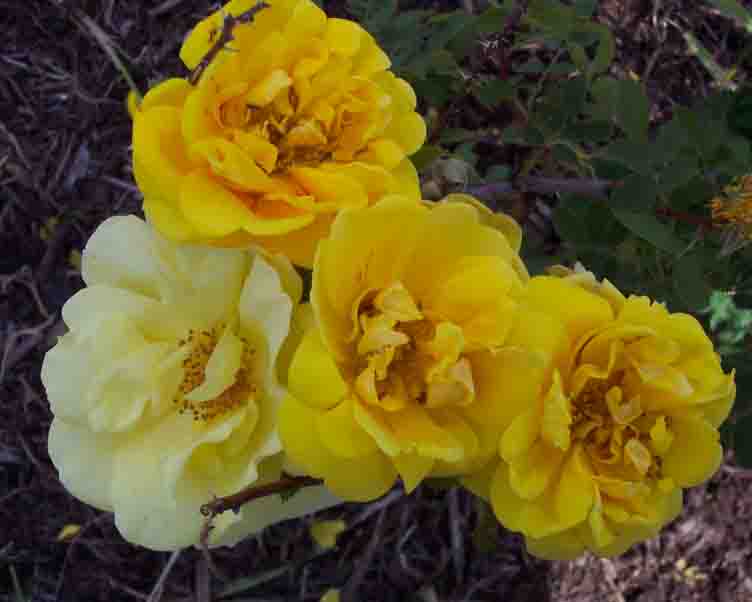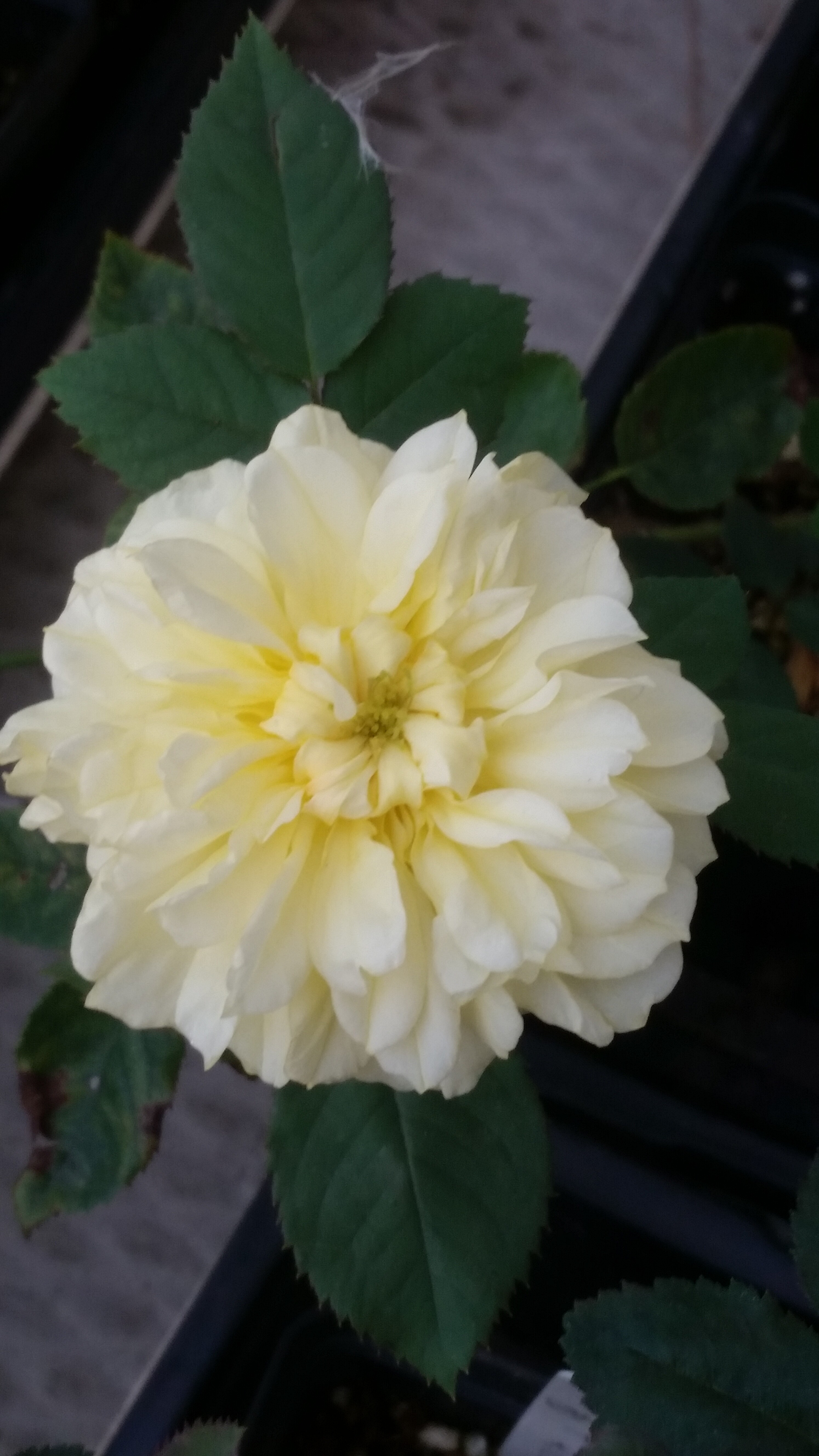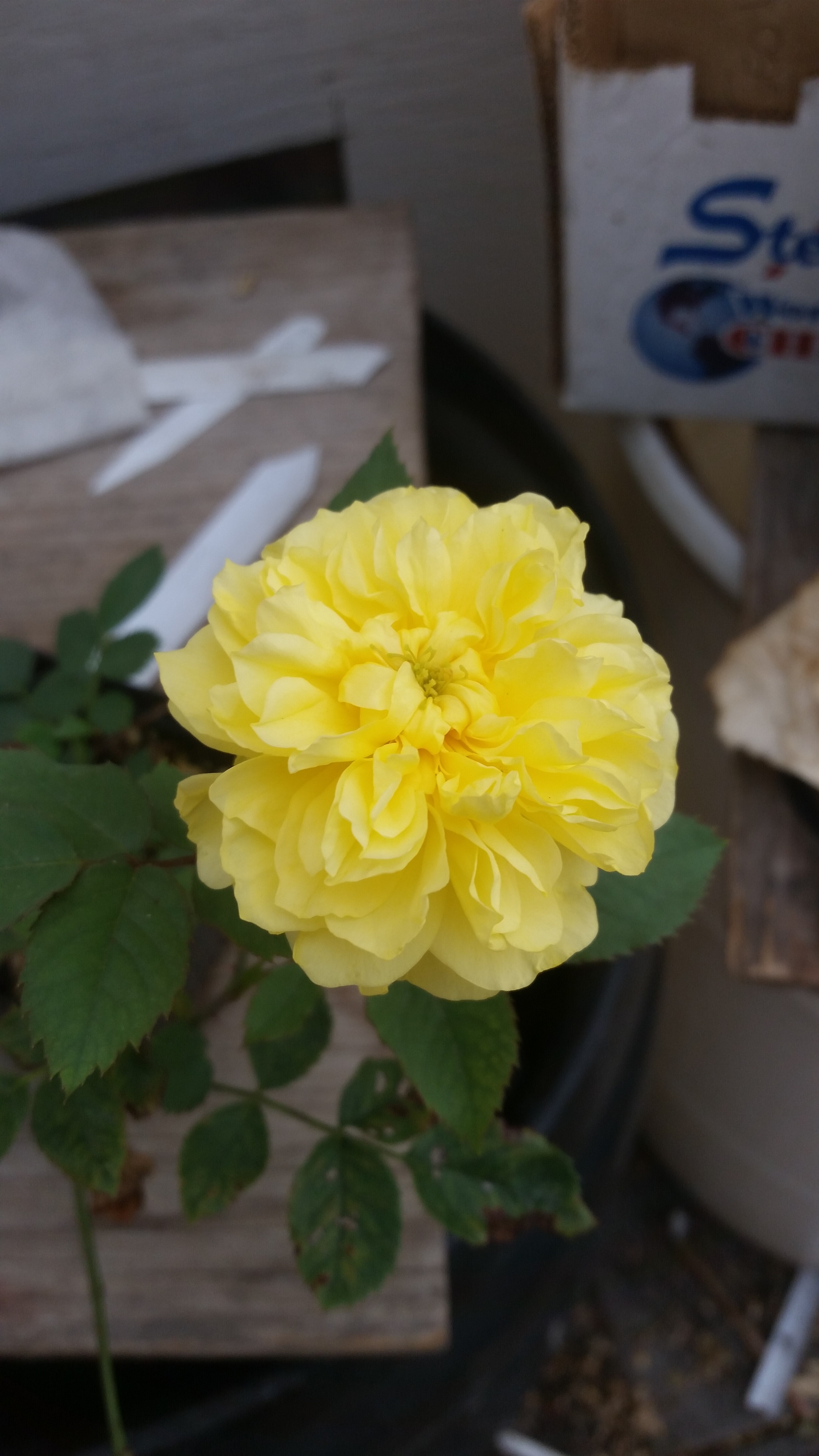In my quest to create yellow roses that can survive my Z3b climate I’ve gone through many tender yellow roses. Crossing them with roses from Z3, like Jonh Davis.
I’ve observe something I need input on. I notice that when I work with pure yellow roses like Sunsprite, or Golden
Glow, these roses fade quite fast in bright sunlight.
When I use roses like Bees knees which have a tinge of red, the yellow pigment is more stable does not fade so quickly and persist for days.
Why is this? Is there any merit to my observations?
Chuckp
Hi Chuck;
Have you thought of using Frühlingsgold , its cold tolerance looks pretty good. I use Maigold which has similar breeding and although its rated at Zone 6 , I think it could go down a little lower than this. Although both only flower in the Spring/summer, I used Maigold as a pollinator onto one of Kordes Hybrid Kordesii’s and all offspring repeat bloom for me. If you want something yellow maybe next Autumn I could send some seed to you of a yellow F2 Hybrid R. virginiana. Combining them with these Hybrid Spins could be beneficial to you.
Warren
I’ve noticed that too with the richer yellows seeming to be able to produce some anthocyanin pigments, but don’t understand the interrelationships. Carotenoids are fat soluble and in different parts of the cell than anthocyanins which are water soluble and typically in the vacuole. Maybe anthocyanins protect carotenoids from UV light to some degree??? For instance, ‘Persian Yellow’ definitely has some red streaks in it at times showcasing it can produce some anthocyanins. I wonder if there is slight production of anthocyanins throughout the epidermal cells that we don’t easily see that contribute to our overall perception of yellow/gold color and protection of carotenoids. (‘Carefree Sunshine’ is the lighter yellow rose in the photo with ‘Persian Yellow’ to highlight the differences in yellow intensity).

Maybe anthocyanins protect carotenoids from UV light to some degree???
My pet theory is that anthocyanins are accessory photosynthetic antennae molecules. The are maximally absorptive at the wavelengths at which chlorophyll (and, hence, carotenoids) are minimally absorptive. They also occur, in leaves, at increasing amounts at increasing latitudes although I can’t find the citation for that just now.
I’m also pretty sure that their emission spectra are offset from the absorption spectra to a degree that shifts into the absorption region of chlorophyll. Some are actually fluorescent.
Chuck,
There may be a connection with flavones and flavonols, which are chemical cousins of the anthocyanin pigments. These non-pigment flavonoids include quercitin, apigenin, luteolin. They also serve as anti-oxidants and “sun blockers”, which could help protect the carotenes. The yellowish luteolin also tends to darken in sunlight, augmenting the color of yellow roses as the carotenes fade.
BTW: ‘Golden Glow’ (Brownell) sometimes gets a flush of red.
http://bulbnrose.x10.mx/Roses/Rose_Pictures/G/goldenglow.html
Karl is likely onto something about the anthocyanins as sun blockers. The leuco form (colorless to our eyes) will absorb UV light powerfully. If the carotenoid in question is being broken by absorption at that same wavelength, the leucoanthocyanin may protect it. Flavanols and flavones are just different derivatives in the same family. They are co-pigments of white, and help build the color intensity of other colors (reds/pinks) which would seem pale and insipid if not having the copigments present. An alternative would be that the carotenoids actually are different such as vitamin A vs xanthophyll. Both are some shade of yellow but the more oxidized xanthophyll is more toward the orange end of yellow. Consider tomatoes with yellow or red flesh depending on lycopene levels, derived from carotene pool. Too many possibilities to remember them all. Eugster’s work discusses this. I think you can search it out on the forum.
More than you ever wanted to know about carotenes in roses.
http://bulbnrose.x10.mx/Roses/breeding/EugsterCarotene1991/EugsterCarotene1991.html
Looking for recommends of yellow roses hold their yellow colour and don’t fade readily in sunlight.
Chuckp
That depends greatly on the intensity of the sun. In the mid desert, just north of Los Angeles, the most colorfast yellow was Golden Holstein. Yellows faded very quickly in the high UV, intense sun and high heat, but that one held better than most.
Could ‘Cläre Grammerstorf’ play a roll in your plan?
Hi Rob,
I would love to try Clare Grammerstorf, but it’s not available in Canada. Someone suggested that
Bud wood should be sent to a nursery in Canada, but I’m not sure how far along that idea got.
Take a look at this seedling. The two pictures were taken 24 hours apart.
I find that Hazeldean is the only rose that holds its deep yellow pigment, but that’s not transmitted
to it’s offspring.
PS; This seedling is not a Hazeldean seedling.
Chuckp


That"s a very pretty bloom Chuck. Too bad it fades so quicly for your purposes. I have Cläre Grammerstorf and plan on using it tNext season for the first time. I’m hoping for some non-fading yellows.
Rob
Perhaps you will be able to send Cläre Grammerstorf pollen to Canada next season?
Thanks Rob,
I was going for the “David Austinish” look. I’ll be testing this and some other yellow seedling for winter
hardiness this year.
Chuckp
Chuck,
I really like the blossom. Good luck with this one.
Margit,
I’d be very happy to send you Clare pollen next season. Please remind me.
Chuck,
I can’t comment on its hardiness, but ‘Goldilocks’ (seedling x Doubloons) is not TOO remotely descended from R. setigera.
‘Allgold’ (Goldilocks x Ellinor Le Grice) is more stable in its color, but another generation removed from Setigera. I’ve only seen it in San Jose, so I know nothing of its hardiness.
I’m seeing the first blooms of last year’s- 2015, seedlings. As you all would agree. I’m amaze when I go out to the seedling beds.
I have made an observation. When I cross a tender yellow with hardy rose, the resulting seedlings follows the
Stat of 13% yellows. The pink seedlings are mostly double to very double. The yellow seedlings are singles or with low
Petal count of under 20 petals.
Is they any connection between hardiness and low petal count in yellow roses?
Examples:-
Chuckp
It seems logical there would be, Chuck. Many petals usually require a lot of heat and intense sun to form and fully open, two conditions which don’t seem they would occur regularly in colder, shorter season zones. Lower petal counts of smaller size require much less energy to form and open, making them more suitable for those conditions.
This could be a matter of linkage, but more study would be needed.
In Jardins de France 1 : 725 (1900), M. Allard wrote, “Having harvested at different times of the fruits of Rosa harrisonii, I planted the seeds and got a variety of roses with single flowers, white, pink, yellow and one semi-double flower, with the same color and tone as that of Rosa lutea Miller. All are dwarf shrubs that run with the Rosa pimpinellifolia, for the main characters: prickles, leaves, purple black fruit, etc.”
In this small sample, singles (of various colors) were more common than one semi-double yellow. This last variety was presumably ‘Allard’, a twice-grandparent of ‘Ormiston Roy’.
Karl
Anyone has an ample supply of David Austin’s Golden Celebration pollen they can share with me?
I would love to pollinate about 100 of my winter hardy pink roses with GC to test my hypothesis.
Why GC? It is very double. Some of the progeny should inherit this doubliness.
You can reach me with a PM.
Chuckp